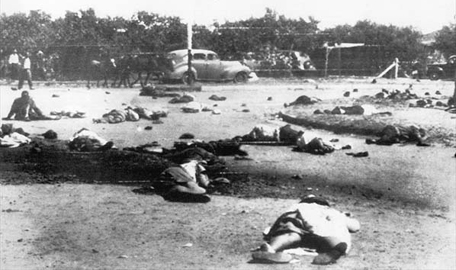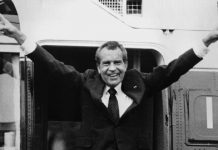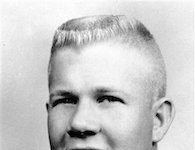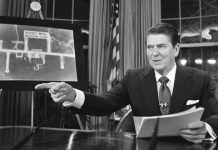On March 21, 1960, South African police fired into a crowd of black protesters who had surrounded a police station in Sharpeville, killing 69 and injuring an estimated 180 people. The massacre received international condemnation and changed the tone of the anti-apartheid movement.
The Sharpeville Massacre
The Sharpeville protests began over South Africa’s pass laws, which required black South Africans to carry pass books with them any time they traveled out of their designated home areas. The African National Congress, the leading anti-apartheid organization of the era, planned for an anti-pass campaign to being March 31, 1960. The Pan Africanist Congress (PAC), a more militant offshoot of the ANC, organized a campaign that would begin 10 days before the ANC’s.
On March 21, PAC leaders in Sharpeville assembled a demonstration of 5,000–7,000 people, in part through intimidating locals to join. In the morning, they led the protest to the Sharpeville police station, where they demanded to be arrested for not carrying passes. The police received reinforcements during the day.
In the afternoon, small scuffles broke out and some demonstrators began throwing rocks at the police. As the crowd moved forward toward one scuffle, the police began firing into the crowd.
The Guardian reported, “As the police advanced, a barrage of stones, sticks, and bottles rained on them and the crowd from surrounding buildings…A fresh barrage of stones struck the policemen, some of whom picked them up and hurled them at the crowd. Africans yelled at the police, ‘Cowards’ and ‘Kill the white men.’ At this stage firing broke out and, after the square cleared, a number of bodies were seen on the ground.
Humphrey Tyler, a white assistant editor at Drum magazine, was in the crowd, which he described as peaceful and little threat to the police’s safety. He wrote, “Before the shooting, I heard no warning to the crowd to disperse. There was no warning volley. When the shooting started it did not stop until there was no living thing in the huge compound in front of the police station. The police have claimed they were in desperate danger because the crowd was stoning them. Yet only three policemen were reported to have been hit by stones—and more than 200 Africans were shot down.”
Sources in this Story
- South African History Online: Sharpeville Massacre
- The Guardian: 22 March 1960: Dozens killed in Sharpeville
- South African History Archive: Human rights and history: SAHA reflects on the Sharpeville Massacre and how it changed South Africa
- The New York Times: Tragedy at Sharpeville
The Consequences of the Sharpeville Massacre
The shootings sparked protests and riots among black South Africans throughout the country. On March 30, the government declared a state of emergency; it arrested thousands of blacks and outlawed the ANC and PAC.
The Sharpeville massacre represents a turning point in the history of apartheid. Banning the ANC and PAC forced anti-apartheid leaders underground and convinced them to end their campaigns of passive, non-violent resistance in favor of armed struggle.
The Sharpeville massacre also brought international condemnation on South Africa, including a United Nations resolution. A New York Times editorial said, “Do the South Africans really think that the rest of the world will ignore such a massacre? Perhaps it takes a horror like the slaughter at Sharpeville to bring home to the white South Africans themselves the evil that the policy of apartheid represents.”
South Africa Content
- Nelson Mandela’s Release From Prison
- Soweto Uprising
- Nelson Mandela Profile
- Archbishop Desmond Tutu Profile
Historical Context: Apartheid
After winning the 1948 elections, the white Afrikaner National Party moved to consolidate its hold on power with the introduction of racially discriminatory measures known collectively as apartheid. Learn more about the history of apartheid with the Apartheid Museum’s page for teachers and students.
In 2012, we published this article about this historic event on The New York Times Learning Network. This article connected the event to current issues and offered reflection questions to help the reader think about its relevance today.











